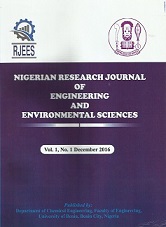Removal of Cadmium from Wastewater using Rice Husk Activated Carbon
Authors: Adamu A, Adie DB, Okuofu CA, Giwa A
DOI Info: N/A
ABSTRACT
The availability of significant quantities of rice husk in the environment and the pollution they generate is disturbing, hence the need to put them to a useful application. Rice husk activated carbon was produced using both thermal and chemical methods. The rice husk was subjected to carbonization temperature of 400 oC for a period of 1 hour in an electric furnace. It was then impregnated with 1M tetraoxophosphate (V) (H3PO4) in a ratio of 2:1 for a period of 3 hours. Batch adsorption study was conducted using adsorbent dosage of 1-5g, initial cadmium concentration of 5-25mg/l, shaking time of 0-120 mins, solution pH of 2-10 and temperature of 30-50 oC. The results showed that the optimum dosage was 3g while the initial cadmium concentration, shaking time, pH and temperature were 25 mg/l, 10 mins, 6 and 30 oC, respectively. The adsorption isotherm investigation revealed that the adsorption process followed Freundlich, Duvinin Radushkevich and Temkin models with corresponding R2 values of 0.9468, 0.9468 and 1.0000, respectively. The adsorption kinetics followed intra particle diffusion model with R2 value of 1.0000. The adsorption thermodynamic data obtained indicated that the adsorption process was exothermic. It was concluded that rice husk can be effectively used for the production of activated carbon and its application for cadmium removal from wastewater was also efficient.
Affiliations: Department of Water Resources and Environmental Engineering, Ahmadu Bello University, Zaria, Nigeria.
Keywords: Rice Husk, Activated Carbon, Adsorption, Optimum Condition, Isotherm
Published date: 2018/12/30









